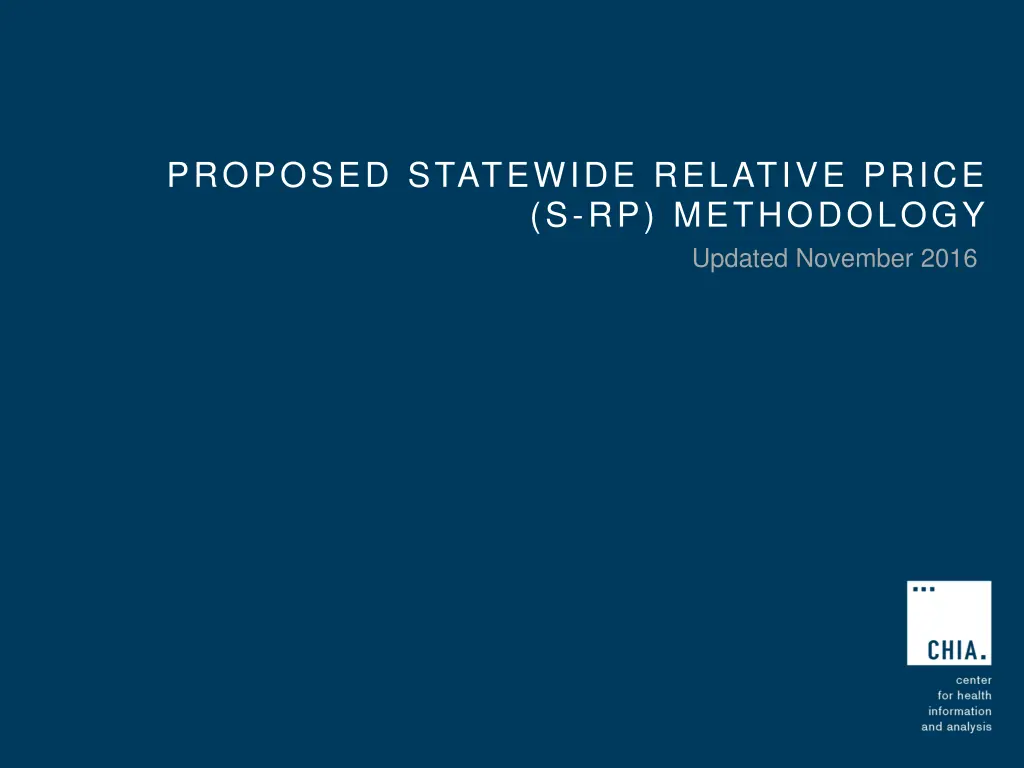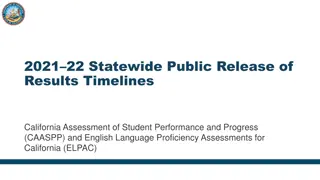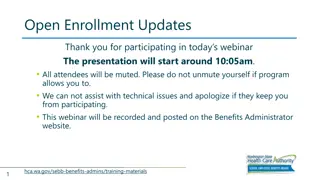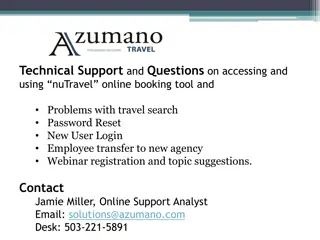
Statewide Relative Price (S-RP) Methodology Overview
Learn about the proposed Statewide Relative Price (S-RP) Methodology updated in November 2016, which aims to evaluate and support eligible acute care hospitals based on relative pricing criteria. The methodology involves blending provider rates across payers to determine eligibility for funding from the Community Hospital Reinvestment Trust Fund (CHRTF).
Uploaded on | 0 Views
Download Presentation

Please find below an Image/Link to download the presentation.
The content on the website is provided AS IS for your information and personal use only. It may not be sold, licensed, or shared on other websites without obtaining consent from the author. If you encounter any issues during the download, it is possible that the publisher has removed the file from their server.
You are allowed to download the files provided on this website for personal or commercial use, subject to the condition that they are used lawfully. All files are the property of their respective owners.
The content on the website is provided AS IS for your information and personal use only. It may not be sold, licensed, or shared on other websites without obtaining consent from the author.
E N D
Presentation Transcript
PROPOSED STATEWIDE RELATIVE PRICE (S-RP) METHODOLOGY Updated November 2016
Statewide Relative Price (S-RP) Background Chapter 115 of the Acts of 2016 created the Community Hospital Reinvestment Trust Fund (CHRTF). The CHRTF is managed by the Secretary of EOHHS and is intended to be used to provide financial support to eligible acute care hospitals. To be eligible to receive payment from the fund, an acute care hospital shall not be a hospital with relative prices that are at or above 120 per cent of the statewide median relative price, as determined by the center for health information analysis.1 CHIA must develop a S-RP methodology to determine which acute care hospitals are eligible to receive payments from the CHRTF. EOHHS: Executive Office of Health and Human Services 1. Additionally, an acute care hospital must be licensed under Section 51 of Chapter 111. Source: Ch. 115 of the Acts of 2016. An Act Relative to Equitable Health Care Pricing. May 31, 2016. https://malegislature.gov/Laws/SessionLaws/Acts/2016/Chapter115. 2
Guiding Principles for S-RP Measure Development CHIA currently collects and reports on relative price (RP) data for acute care hospitals on an annual basis. However, the conventional RP measure does not readily lend itself to calculating a statewide metric due to its payer-specific construction and lack of standardized outpatient payment data components across payers. Given this context, CHIA maintained two guiding principles for the development of a S-RP measure: 1) the method must be methodologically sound and leverage the existing framework and core data of the conventional RP method; and 2) the method should be calibrated to reflect each provider s individual experience to the extent practical. 3
RP Background RP is an aggregate measure used to evaluate variation in prices for similar providers within individual payer networks. o By construction, the network average RP equals 1.0 for each payer network. o This measure allows for a relative comparison of each provider s price level within a given payer network in a given year. However, because RP is specific to each payer s network, RP values are not directly comparable across payers. o A provider with a higher RP for a given payer may not have higher prices than it has with other payers where its RP is lower. o As a result, RP cannot be used to draw conclusions about absolute price levels across payers. Source: CHIA. Relative Price Methodology Paper. September 2016. http://www.chiamass.gov/assets/docs/r/pubs/16/RP-Methodology-Paper-9-15-16.pdf. 4
Proposed S-RP Methodology: Provider- Weighted Blending After reviewing 2014 and 2015 RP data and considering input from actuarial consultants and other stakeholders, CHIA proposes the following S-RP methodology: 1. Blend each provider s inpatient adjusted base rate (ABR) across payers based on the payer share of inpatient payments for each provider and convert the cross-payer ABRs to relativities; 2. Blend each provider s outpatient RP across payers based on the payer share of outpatient payments for each provider; 3. Blend each provider s cross-payer inpatient and outpatient S- RPs into a single blended cross-payer S-RP based on the inpatient/outpatient share of payments for each provider. We believe this approach achieves the most accurate measure of S-RP and is as reflective of each provider s experience as practical. Note: CHIA will use commercially-insured member data to calculate the median statewide RP for the purposes of determining eligibility for CHRTF payments. 5
Example Calculation: Inpatient S-RP Step 1a: Calculate product-adjusted, payer-specific payments per case-mix adjusted discharge (i.e., product-adjusted ABR) Product-Adjusted ABR Payer Share of Total Hospital-Specific Inpatient Payments (claims + non-claims) $10,000 $12,000 $8,000 $9,500 $10,000 $12,000 $15,000 $13,500 Hospital Hospital 1 Hospital 1 Hospital 1 Hospital 2 Hospital 2 Hospital 2 Hospital 3 Hospital 3 Step 1b: Combine payer-specific ABRs into a single, cross-payer ABR for each hospital using the share of total inpatient payments made by each payer to a given hospital to weight each payer-specific ABR Hospital Payer Insurance Category Product Type Payer Payer A Payer B Payer C Payer A Payer B Payer C Payer A Payer C Insurance Category Commercial Commercial Commercial Commercial Commercial Commercial Commercial Commercial Product Type All Types Combined All Types Combined All Types Combined All Types Combined All Types Combined All Types Combined All Types Combined All Types Combined 30% 12% 58% 33% 37.5% 30% 40% 60% Cross-Payer ABR = Sum of ("Product-Adjusted ABR" series * "Share of Total Hospital- Specific Inpatient Payments" series) Hospital 1 Hospital 2 Hospital 3 Step 1c: Compute statewide average ABR as the mean across all hospitals of the cross-payer ABRs calculated in step 1b Statewide Average Inpatient ABR = Average of "Cross-Payer ABR" series $11,202 Step 1d: Calculate the cross-payer inpatient S-RP values for each hospital by dividing the hospital-specific all-payer ABRs (1b) by the statewide average cross-payer ABR (1c) Hospital Payer Insurance Category Product Type N/A N/A N/A Commercial Commercial Commercial All Types Combined All Types Combined All Types Combined $9,080 $10,425 $14,100 Cross-Payer Inpatient S-RP = Hospital X "Cross-Payer ABR" / "Statewide Average Inpatient ABR" Hospital 1 Hospital 2 Hospital 3 N/A N/A N/A Commercial Commercial Commercial All Types Combined All Types Combined All Types Combined 0.81 0.93 1.26 6
Example Calculation: Outpatient S-RP Step 1f: Calculate payer-specific outpatient RPs by dividing the payer-specific adjusted rates by the payer-specific network average adjusted rate Payer Share of Total Hospital-Specific Outpatient Payments (claims + non-claims) Hospital Hospital 1 Hospital 1 Hospital 1 Hospital 2 Hospital 2 Hospital 2 Hospital 3 Hospital 3 Step 1g: Combine the payer-specific RPs into a single, cross-payer RP for each hospital using the share of total outpatient payments made by each payer to a given hospital to weight each RP Hospital Payer Ins. Cat. Product Type Cross-Payer Outpatient RP = Sum of Hospital X ("Payer-Specific Outpatient RP" * "Share of Total Hospital- Specific Outpatient Payments") Hospital 1 N/A Commercial All Types Combined Hospital 2 N/A Commercial All Types Combined Hospital 3 N/A Commercial All Types Combined Step 1h: Compute the statewide average outpatient cross-payer RP as the mean of the hospital-specific cross-payer RP calculated in step 1g Statewide Average Cross-Payer Outpatient RP = Average "Cross-Payer Outpatient RP" series 1.04 Step 1i: Calculate the cross-payer outpatient S-RP for each hospital by dividing the hospital-specific all-payer adjusted rates (1g) by the statewide average (1h) Hospital Payer Ins. Cat. Product Type Cross-Payer Outpatient S-RP = Hospital X "Cross-Payer Outpatient RP" / "Statewide Average Cross-Payer Outpatient RP" Hospital 1 N/A Commercial All Types Combined Hospital 2 N/A Commercial All Types Combined Hospital 3 N/A Commercial All Types Combined Payer Payer A Payer B Payer C Payer A Payer B Payer C Payer A Payer C Ins. Cat. Commercial Commercial Commercial Commercial Commercial Commercial Commercial Commercial Product Type All Types Combined All Types Combined All Types Combined All Types Combined All Types Combined All Types Combined All Types Combined All Types Combined Payer-Specific Outpatient RP 0.98 0.69 1.01 0.79 1.31 0.95 1.23 1.05 25.0% 18.0% 57.0% 25.0% 35.0% 40.0% 45.0% 55.0% 0.94 1.03 1.13 0.91 1.00 1.09 7
Example Calculation: Blended S-RP Step 2a: Calculate the share of cross-payer total payments accounting for inpatient and outpatient services for each hospital Cross-Payer Outpatient S-RP Hospital Specific Inpatient Share of Total Spending Hospital Specific Outpatient Share of Total Spending Hospital Hospital 1 Commercial All Types Combined Hospital 2 Commercial All Types Combined Hospital 3 Commercial All Types Combined Step 2b: Using the hospital-specific inpatient and outpatient payment shares calculated in step 2a as weights, combine each hospital s all-payer inpatient and outpatient S-RP values (1d and 1i) Hospital Ins. Cat. Product Type Interim Blended Cross-Payer S-RP = Hospital X ("Cross-Payer Inpatient S-RP" * "Hospital Specific Inpatient Share of Total Spending" + "Cross- Payer Outpatient S-RP" * "Hospital Specific Outpatient Share of Total Spending") Hospital 1 Commercial All Types Combined Hospital 2 Commercial All Types Combined Hospital 3 Commercial All Types Combined Step 2c: Compute the statewide average of the interim blended cross-payer S-RP as the mean of the hospital-specific interim blended cross-payer S-RP calculated in step 2b Statewide Average of Interim Blended Cross-Payer S-RP = Average of "Interim Blended Cross-Payer S-RP" series Ins. Cat. Product Type Cross-Payer Inpatient S-RP 0.81 0.93 1.26 0.91 1.00 1.09 40% 50% 60% 60% 50% 40% 0.87 0.96 1.19 1.01 Step 2d: Calculate the final blended cross-payer S-RP for each hospital by dividing the hospital-specific interim blended cross-payer S-RP (2b) by the statewide average (2c) Hospital Ins. Cat. Product Type Final Blended Cross-Payer S-RP = Hospital X "Interim Blended Cross-Payer S-RP"/"Statewide Average of Interim Blended Cross-Payer S-RP" Hospital 1 Commercial All Types Combined Hospital 2 Commercial All Types Combined Hospital 3 Commercial All Types Combined Step 3: Calculate Median Statewide RP Median S-RP = Median "Blended Cross-Payer S-RP" Series 0.86 0.96 1.18 120% of Median S-RP = 1.2 * "Median S-RP" 0.96 1.15 8
Acute Care Hospitals Anna Jaques Hospital Athol Memorial Hospital Baystate Franklin Medical Center Baystate Mary Lane Hospital Baystate Medical Center Baystate Noble Hospital Baystate Wing Hospital Berkshire Medical Center Beth Israel Deaconess Hospital - Milton Beth Israel Deaconess Hospital - Needham Beth Israel Deaconess Hospital - Plymouth Beth Israel Deaconess Medical Center Boston Children's Hospital Boston Medical Center Brigham and Women's Faulkner Hospital Brigham and Women's Hospital Cambridge Health Alliance Cape Cod Hospital Clinton Hospital - A member of the UMASS Memorial Health Center Cooley Dickinson Hospital Dana-Farber Cancer Institute Emerson Hospital Fairview Hospital Falmouth Hospital Hallmark Health Harrington Memorial Hospital HealthAlliance Hospital Heywood Hospital Holy Family Hospital Holyoke Medical Center Lahey Health - Winchester Hospital Lahey Hospital & Medical Center Lawrence General Hospital Lowell General Hospital Marlborough Hospital - A member of the UMASS Memorial Health Center Martha's Vineyard Hospital Massachusetts Eye and Ear Infirmary Massachusetts General Hospital Mercy Medical Center MetroWest Medical Center Milford Regional Medical Center Morton Hospital, A Steward Family Hospital, Inc. Mount Auburn Hospital Nantucket Cottage Hospital Nashoba Valley Medical Center New England Baptist Hospital Newton-Wellesley Hospital North Shore Medical Center Northeast Hospital Saint Vincent Hospital Shriners Hospitals for Children Boston Shriners Hospitals for Children Springfield Signature Healthcare Brockton Hospital South Shore Hospital Southcoast Hospitals Group Steward Carney Hospital, Inc. Steward Good Samaritan Medical Center Steward Norwood Hospital, Inc. Steward Saint Anne's Hospital, Inc. Steward St. Elizabeth's Medical Center Sturdy Memorial Hospital Tufts Medical Center UMass Memorial Medical Center 9
Next Steps CHIA is currently finalizing our calendar year 2015 S-RP analysis using the proposed methodology. Based on our preliminary review of the data, CHIA expects approximately 50-55 acute care hospitals to be meet this eligibility criterion. CHIA will publish the contents of this webinar on our website today and will add aggregate results from our preliminary analysis when complete. We intend to publish the aggregate results by early next week. CHIA will transmit individual hospital results using the proposed methodology to the Chief Financial Officer or equivalent of each acute care hospital upon completion of our preliminary analysis. Hospitals will only receive their own results. 10
Public Comment CHIA requests public comment on the proposed methodology for calculating S-RP. To be assured consideration, comments must be received no later than 5 p.m. ET on Friday, December 9th. Comments may only be submitted electronically via email. All comments should be emailed to tmerp@state.ma.us and should include the following subject line: Statewide RP Methods . Following a review of the submitted comments, CHIA will issue a final methodology for calculating S-RP and will release results based on existing calendar year CY 2015 relative price data. 11
Questions? 12






















